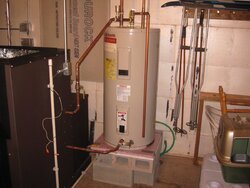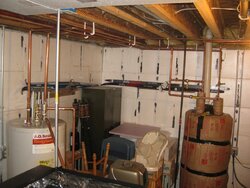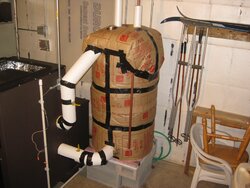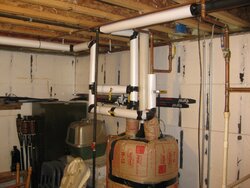I would like some input on putting a hot water coil inside my wood furnace. I pretty much set myself up for one last season, but I didn't get one. I bought an lp water heater and connected it to my electric hot water heater to use it as a holding tank to increase capacity and I bought all the extra copper pipe. Couple questions. Is it worth it? It's around $300 for my furnace. Is there any difference in brands? I see there is a couple places that have 24" ones and I could save myself almost half the price over the furnace brand one. Is it easy to put in? It's a fairly new furnace so I don't want to mess up cutting the holes.
Hot water coil
- Thread starter Wisneaky
- Start date
-
Active since 1995, Hearth.com is THE place on the internet for free information and advice about wood stoves, pellet stoves and other energy saving equipment.
We strive to provide opinions, articles, discussions and history related to Hearth Products and in a more general sense, energy issues.
We promote the EFFICIENT, RESPONSIBLE, CLEAN and SAFE use of all fuels, whether renewable or fossil.
You are using an out of date browser. It may not display this or other websites correctly.
You should upgrade or use an alternative browser.
You should upgrade or use an alternative browser.
- Status
- Not open for further replies.
Isaac Carlson
Minister of Fire
What brand and model "furnace" do you have and how much hot water do you need? There are a lot of variables when it comes to heating water. How hot your fire is, tank size, pipe diameter, coil size, water usage, etc...
Isaac Carlson
Minister of Fire
One thing I want to add is that steel is easy to work with. IF you did mess up when cutting the holes, it can easily be welded.
My furnace is a Shelter SF2631
I have two 50 gallon tanks one is the old electric one not hooked up just used for storage and it is ran into my LP 50 gallon tank. So I'd be heating 100 gallons total. I have 3/4 inch pipe to both. I was looking into getting the 24" coil. My fire box is really big and can hold a lot of wood or coal. We have 6 people in our house so we probably use a lot of water.
I have two 50 gallon tanks one is the old electric one not hooked up just used for storage and it is ran into my LP 50 gallon tank. So I'd be heating 100 gallons total. I have 3/4 inch pipe to both. I was looking into getting the 24" coil. My fire box is really big and can hold a lot of wood or coal. We have 6 people in our house so we probably use a lot of water.
maple1
Minister of Fire
Are you talking right in the firebox? Or just outside, like in the plenum or right above the firebox?
(Not familiar with a Shelter here).
(Not familiar with a Shelter here).
Yes it would be in the firebox. I was wondering if anyone has used them. I have to cut two holes to install it and I don't want to cut the holes if it isn't worth it.Are you talking right in the firebox? Or just outside, like in the plenum or right above the firebox?
(Not familiar with a Shelter here).
Isaac Carlson
Minister of Fire
Are you going to have a circulator pump or rely on gravity? If you have a pump you can put your tanks anywhere. If you want to use gravity the tanks will have to be higher than the stove. You have to have 2 feet of rise for every foot of run for good circulation and your pipes should be at least 1". If your pipes and tanks are insulated, it might work, but I would suggest a bigger coil. Hilcoil makes them or you can look elsewhere. The other option would be to use 2 coils.
( You have to have 2 feet of rise for every foot of run for good circulation )
You say 2 feet of rise per 1foot of run? I was under the impression I need bottom of tank higher than coil. I'm in the process of installing dhw now with gravity. Are you saying if tank is 3foot from stove I need it 6 foot higher than stove? Please elaborate . I want to have my install working the 1st time. Thank you .
You say 2 feet of rise per 1foot of run? I was under the impression I need bottom of tank higher than coil. I'm in the process of installing dhw now with gravity. Are you saying if tank is 3foot from stove I need it 6 foot higher than stove? Please elaborate . I want to have my install working the 1st time. Thank you .
maple1
Minister of Fire
I think the hot water that leaves the stove would enter at the top of your tank. So ideally the top of the tank where the hot water enters would be 6 feet higher than where it exits the stove. Is what I believe the 2:1 thing means. Going sideways really kills the flow.
maple1
Minister of Fire
Yes, you'd want that too. Otherwise the coldest water will be asked to go up, which it wouldn't like.
They don't call for 2' of rise or for the tank to be 6' off the ground like others have said here.( You have to have 2 feet of rise for every foot of run for good circulation )
You say 2 feet of rise per 1foot of run? I was under the impression I need bottom of tank higher than coil. I'm in the process of installing dhw now with gravity. Are you saying if tank is 3foot from stove I need it 6 foot higher than stove? Please elaborate . I want to have my install working the 1st time. Thank you .
Last edited:
brenndatomu
Minister of Fire
Here is the Hot Rod, only one hole to cut. $259 IIRC http://www.yukon-eagle.com/LinkClick.aspx?link=61&tabid=36I have to cut two holes to install it and I don't want to cut the holes if it isn't worth it.
I don't have one but the people I have talked to that have used this kind of setup are happy with 'em.
Correct. The more rise the better, but if everything else is done correctly it'll work with minimal riseThey don't call for 2' of rise or for the tank to be 6' off the ground like others have said here.
STIHLY DAN
Minister of Fire
maple1
Minister of Fire
Isaac Carlson
Minister of Fire
That hot rod is not going to give much hot water at 18 gallons per hour and 80 degree temp rise. You need a coil.
The tank can be on the floor next to the stove as long as the coil is at or below the middle of the tank. The 2:1 rule applies if you are locating the tank away from the stove.
Circulation is your friend with this kind of setup. Too little flow and your water will not get hot. To much flow and your water will not get hot. Give it a decent size pipe and coil with a good flow path (as vertical as possible) and you should be good to go. If you are going to be heating 100 gallons of water, you will need a coil bigger than a single 24". I would suggest a double 18-24" coil and 1" stainless pipe. Avoid bends and use 45 degree elbows if possible. Horizontal runs are the enemy to circulation and reduce it exponentially. This does not mean you can't have a foot of horizontal pipe as this will not hurt a properly designed system. I would suggest a minimum of 2/3 of the piping to be vertical for good circulation. If the tank will be a distance from the stove it will have to be elevated to some degree. Sloping your pipes at a 45 degree angle between the tank and stove will be much better that horizontal/vertical runs. Put a temp probe on the tank and use it. You should shoot for 140-160 for a water temp. That gives good efficiency and circulation. A smaller volume of water at 140+ will outlast a larger supply at 120 degrees once mixed with cold to ~110. This is why 160 degrees is more efficient than a lower temp because you are burning the wood either way and you might as well get the water hot and use less of it.
I hope this is clear.
The tank can be on the floor next to the stove as long as the coil is at or below the middle of the tank. The 2:1 rule applies if you are locating the tank away from the stove.
Circulation is your friend with this kind of setup. Too little flow and your water will not get hot. To much flow and your water will not get hot. Give it a decent size pipe and coil with a good flow path (as vertical as possible) and you should be good to go. If you are going to be heating 100 gallons of water, you will need a coil bigger than a single 24". I would suggest a double 18-24" coil and 1" stainless pipe. Avoid bends and use 45 degree elbows if possible. Horizontal runs are the enemy to circulation and reduce it exponentially. This does not mean you can't have a foot of horizontal pipe as this will not hurt a properly designed system. I would suggest a minimum of 2/3 of the piping to be vertical for good circulation. If the tank will be a distance from the stove it will have to be elevated to some degree. Sloping your pipes at a 45 degree angle between the tank and stove will be much better that horizontal/vertical runs. Put a temp probe on the tank and use it. You should shoot for 140-160 for a water temp. That gives good efficiency and circulation. A smaller volume of water at 140+ will outlast a larger supply at 120 degrees once mixed with cold to ~110. This is why 160 degrees is more efficient than a lower temp because you are burning the wood either way and you might as well get the water hot and use less of it.
I hope this is clear.
maple1
Minister of Fire
That depends on how much hot water you use too. 18gpm over 24 hours is a lot. The size of the water tank can really come into play when heating water by convection - the bigger the reserve the better. I started out with a sidearm on my new boiler setup with convection flow only, and went with an 80 gallon electric water heater for the tank. Family of 5, always lots of hot water during the heating season. It's also a good idea to have a mixing valve on the outlet of the tank, the water should be pretty hot by the time morning comes (might have already been mentioned).
Yes I was also thinking of using a mixing valve.That depends on how much hot water you use too. 18gpm over 24 hours is a lot. The size of the water tank can really come into play when heating water by convection - the bigger the reserve the better. I started out with a sidearm on my new boiler setup with convection flow only, and went with an 80 gallon electric water heater for the tank. Family of 5, always lots of hot water during the heating season. It's also a good idea to have a mixing valve on the outlet of the tank, the water should be pretty hot by the time morning comes (might have already been mentioned).
JRHAWK9
Minister of Fire
I think this thread got away from my original intentions and now that I look at my original post I should have worded it differently. I have it mostly all plumbed. I just don't have the coil. I was wondering it the coils actually work and how well they work, do they keep the water hot all the time, is it worth the initial cost of the coil? And when I asked if it was easy to put in I meant is it easy to cut the holes in the furnace? Thanks everyone
JRHAWK9
Minister of Fire
I think this thread got away from my original intentions and now that I look at my original post I should have worded it differently. I have it mostly all plumbed. I just don't have the coil. I was wondering it the coils actually work and how well they work, do they keep the water hot all the time, is it worth the initial cost of the coil? And when I asked if it was easy to put in I meant is it easy to cut the holes in the furnace? Thanks everyone
Can you mount it to the rear/side of the firebox? I wouldn't want to be drilling holes into the firebox. I'd think you would possibly be opening yourself up to issues down the road. Kuuma's have it bolted to the back and it works great. EPA will not allow holes into the firebox.
The instructions for mine is to drill the holes on the back side into the firebox.Can you mount it to the rear/side of the firebox? I wouldn't want to be drilling holes into the firebox. I'd think you would possibly be opening yourself up to issues down the road. Kuuma's have it bolted to the back and it works great. EPA will not allow holes into the firebox.
brenndatomu
Minister of Fire
What, you thought we were gonna stay completely on topic?!I think this thread got away from my original intentions
 Silly Wiseneaky...
Silly Wiseneaky...Step drill or hole saw if it is a larger hole neededAnd when I asked if it was easy to put in I meant is it easy to cut the holes in the furnace?
Good thing he doesn't have an "EPA" furnace!EPA will not allow holes into the firebox

- Status
- Not open for further replies.
Similar threads
- Replies
- 4
- Views
- 1K
- Replies
- 1
- Views
- 370
- Replies
- 4
- Views
- 2K
- Replies
- 5
- Views
- 852





